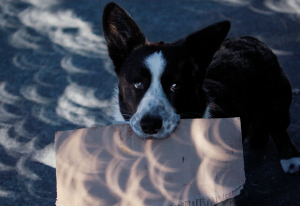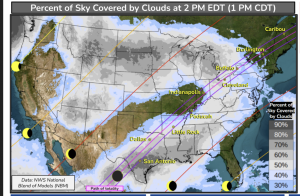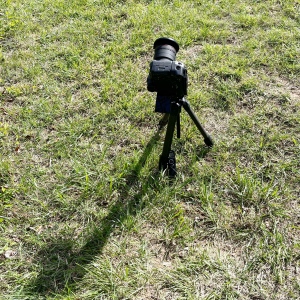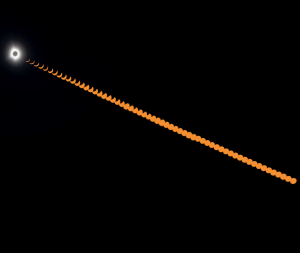The diamond ring at third contact. 1/8000s, f/8, ISO800, 840mm effective. Thin, high cirrus clouds did persist throughout the event from our vantage. I think that might account for some of the interesting refraction artifacts going on in this image. I hope Pink Floyd would approve of it.
A 7-frame exposure stack of the April 8, 2024 solar corona, taken during totality. Untracked, 1/8000 to 1/3s bracketed, f/8, ISO 800, 840mm effective focal length, cropped to center in post. Aligned by hand (using the difference blend mode). Focus was acquired prior to the event by manually focusing on sunspots during the partial phases. It’s not clear to me if the apparent softness is a focusing error or just due to atmospheric interference. Earthshine on the moon is already visible in the longest exposures; one frame was reprocessed to bring out detail in the moon and stacked. This attempts to be relatively faithful to the naked-eye view.
This is the exact same 7-frame exposure stack as above (without earthshine), but frequency separation was performed after the initial stack. A contrast map of high frequency data was multiplied over the base image. It’s extremely noisy, but it does reveal some fine loops and other details that are missing in the more natural visual representation.
Total Eclipse of the Barks! Featuring my dogs, Ben (Cardigan Welsh Corgi), and Kestrel (Australian Shepherd).
The personal background story that no one cares about
First contact. 1/500, f/8, ISO100. 840mm effective, cropped in post.

On August 21, 2017, we watched a 93% partial solar eclipse from our driveway in Seattle. I took a picture of my dog Rory demonstrating some crescent-shaped pinholes (see right). The total was visible from Oregon, just one state over. For some reason, missing that eclipse didn’t really begin to bother me for a few more years.
By 2022, I’d solidly decided I’d missed out, and I started to work on planning a real attempt to see the next easiest total solar eclipse. Like every other starry-eyed dreamer, I looked at historical cloud cover maps for the full path of totality, and determined our best chances were in the Hill Country of south-central Texas. I was thrilled to learn that the area is also a great place to see fields of bluebonnets in the spring. (Cheesy flowery dog pictures are a bit more up my normal alley than astrophotography). I booked a campsite, and started throwing out ideas for roadtrip stops in the middle of unrelated conversations.
As time went on, of course, the plan kept changing. I accidentally planned a trip to Tasmania right over the roadtrip period (and it was anchored by a conference, so we couldn’t move it). We considered flying. We considered renting a hotel room, renting a van, debated whether we were bringing dogs, how many dogs… (Eventually there were three dogs to consider, making for 8 possible dog combinations. In the end, we brought the two younger dogs, Ben and Kestrel, who could use the flying practice anyway. Rory, who does not hold with flying, stayed home.) These debates continued through to the beginning of 2024, and never quite felt final.
Anyone who was watching forecasts in the week leading up to April 8 knows this part of the story. Weather reports became grimmer and grimmer. I worried about flying dogs through potential severe weather for an increasingly high likelihood of being clouded out. I resolved to be okay missing it: better luck in the 2040s. But midweek, Matthew sent me a gloomy forecast map predicting clouds across almost the whole path of totality, with one obvious clear gap… over southern Illinois.

In all honesty, if it hadn’t been Illinois (our home state, more or less), I doubt we would have bothered, but I was at least driven to do a cursory check for lodging. Which I found. And Matt was driven to verify that we could switch our flights. Which we could. And suddenly all that remained was to find a car… which we couldn’t. In all of STL, not a single rental car remained. Matt told me this in the middle of a phone conversation with my mother, who happens to still live in the college town of Urbana, Illinois, a couple hours north of the path of totality.
My mother said: “Too bad I’m going to Dallas, especially since there will be clouds. Otherwise I could pick you up.”
On Saturday, just before midnight, we collected our dogs, Ben and Kestrel, from their cargo crates, and waited outside for my mother to circle through STL’s passenger pickup zones. We drove a few hours to the small town of Murphysboro, IL. I had a bit of anxiety about the legitimacy of our Airbnb. By then, we’d heard multiple stories of fake or cancelled listings… But the listing was real, the door code worked, and there was a pond out front for the dogs to swim in… So all that remained was for the forecast to hold.
Interesting sandstone hoodoos in the Garden of the Gods Wilderness, a major southern IL attraction. Left, a photograph by 13-year-old me in 2008, and right, 25-year-old me in 2020. While these present an obvious dramatic foreground for a landscape shot, I suspected I wouldn’t be the only person to think so.
We spent Sunday scouting around for viewing locations. (In particular, I was looking for a good wide-angle view.) Ultimately, though the apocalyptic crowds we were warned of hadn’t materialized, we decided it was safest to set up the shots at our Airbnb. (At the time, I was pretty dissatisfied with the lack of a “spectacular” foreground, but now I’m happy with the simplicity of the composition. Go figure.) I spent that evening building a makeshift solar filter for my telephoto lens out of painter’s tape, cardboard, and solar film.
Bailey’s beads at second contact, showing red solar prominences. Four stacked exposures 1/8000s, 1/1000, 1/250, 1/60s; f/8, ISO100.
It didn’t take long after totality faded for my mother to start talking about Egypt 2027! (Sadly, I don’t think there will be a dog image from that, so I’m glad I pulled it off this time around.)
Photography plans
Monday at 11:30, I had my two rigs set up. One Canon R5 had a 15-35mm lens and a commodity solar filter on a small travel tripod. The second was attached to a 600mm lens with a 1.4x converter (840mm effective) mounted on my birding tripod.

My plan for the wide angle was to use an intervalometer to capture partial phases every two minutes as the sun moved across the sky. (The sun moves about one apparent solar diameter every 2 minutes, so I figured this would give me options.) With the filter on, the exposure settings were 1/800, f/8, and ISO 100. I bracketed three frames just in case.
Then I’d take the primary frame(s) of the sequence during totality with the filter off, and merge them together in post for a composite of the full sequence of the solar eclipse over a landscape photo. …With my dogs posed in the foreground, of course. I can’t let well enough alone. The tripod was set at the bottom of a small hill, to reduce the effective angle of the sun relative to the foreground.
The main unknown, which was a big one, was the exposure for the landscape at totality. I didn’t know how dark it would be. Many wide-angle eclipse shots either have composited foregrounds from other times of day, or aren’t exposed for the foreground. I anticipated manually bracketing a number of different exposures to hopefully get some usable ones.

My plan for the telephoto was to set a wide 7-frame bracket from the beginning, and manually take partial phase photos at specific times generated by the app “Solar Eclipse Timer”. I prefocused manually on a sunspot.
A few seconds before second contact, I’d quickly remove the filter and change the exposure settings to capture the diamond ring and Bailey’s beads phases.
Then I’d increase the ISO to 800 and dial into increasingly slow bracketed shots during totality to capture as much of the corona as I could. (Note that with the sun at solar maximum, the corona was massive compared to the 2017 examples I’d seen. 840mm was actually too tight for an expansive corona shot. If I could redo this shoot, I would shoot at 600 and accept cropping in for other phases.)
I wasn’t going into this with preexisting experience exposure stacking astro frames, so I figured that without a star tracker, I was most likely just creating a big mess for myself.
(And I was!)
Given that one (let alone multiple) complicated plan is said to be overly ambitious for a first time eclipse watcher, my biggest concern was running out of time during the roughly 4 minute totality to execute both. I didn’t want to miss actually seeing it, either. I rehearsed the telephoto plan in my head, based on exposure settings from this photography guide, for the entire morning.
A composite of the sequence of partials leading into second contact. 1/500s, f/8, ISO100, except for the last two narrow crescent frames, which were taken at 1/320s and 1/250s respectively.
Execution
A composite of the progression from the diamond ring, to Bailey’s beads, to just the thin red chromosphere, as the eclipse moves into totality. Frames were taken at 1/8000s, f/8, ISO100.
A single frame from the above composite.
At 13:58:45, the filter came off. At 13:59:06, the world went dark. I spun the exposure dial to 1/4000 (f/8, ISO 100, 7 shots bracketed as widely as possible) and watched the diamond ring transition into Bailey’s beads on the LCD. As soon as the beads disappeared, I started to bracket totality shots, increasing the ISO to 800 and working my way down from 1/8000 to 1/3 second exposures. This took about the first minute of totality, but surprisingly, I managed to enjoy it anyway. Wildlife photography has given me passing muscle memory for the dials, so I was able to look at the sky rather than the LCD.

Meanwhile, Matt set up the dogs (“the talent”) in their positions for the wide angle shot (see a behind-the-scenes phone picture of that scene), and I switched over to the other camera. As predicted, I wasn’t well-practiced enough at finding the correct exposures. The dim twilight of totality made it hard to freeze accidental motion from the dogs, while still properly exposing the foreground. I ended up fiddling with it for almost two precious minutes of totality. Oops.
I had one whole final minute to spend staring straight upwards at the black hole in the sky. A confused shorebird fluttered down to the pond. To Matt’s unending disappointment, the crickets that we knew were there did not start singing.
In the past I’ve shot (not asserting any actual skill in this) entities like the comet NEOWISE, the galactic center, and aurora. A typical finished photo isn’t a dishonest representation of those events, but it also isn’t exactly what the eye sees. Cameras pick up more information in a single frame than you can see with your eye. They resolve faint details, bring out invisible colors, and blend movement. So, I was expecting the eclipse to look different to the naked eye than it does in photos. But I was wrong! The hole in the sky, the glowing white corona, the deep blue twilight, and the soft orange glow across the horizon… is exactly what it looks like. That’s pretty cool!
To be honest, after the rush of totality, the slow march of partials out of the eclipse doesn’t feel that thrilling, but I dutifully photographed at the intended time intervals until fourth contact, and left the intervalometer on the wide angle camera running until the sun sank out of the frame.
A composite sequence of eclipse phases. Partial phases were photographed at 1/500s, f/8, ISO100. Total is a 5 frame exposure stack bracketed from 1/8000 to 1/15, f/8, ISO100. Frequency separation was performed to bring out some extra detail in the corona.
Post-processing
In wildlife photography, this is generally where things get boring. There’s usually not that much you can tastefully do in post with wildlife photography. It’s kind of the sport of getting everything “right” in a single shot, in camera. In astrophotography and landscape photography, the story can be very different. I’m terrible at both of them, with no experience whatsoever in advanced techniques, but I thought I’d give it a shot anyway.
My typical workflow as of this writing is to use DxO PhotoLab for raw development, and finish processing to taste in Affinity Photo. I’ve used these since I switched from a laptop running Arch Linux to the current photo-processing drudge, a 2021 M1 MacBook Pro. I haven’t used Lightroom or Photoshop, but seeing as most of the techniques I’ve attempted were adapted directly from techniques written for the Adobe family of products, they can be adapted right back again.
Telephoto corona
The solar corona exhibits massive dynamic range. An exposure that works for the brightest innermost corona won’t capture the faint streamers several solar radii out. Reciprocally, an exposure that can capture the faint outer limits will blow out the interior. So, if one wishes to make an image of the whole corona (at least… the whole corona in the frame…), the only option is to compress the dynamic range with exposure stacking.
The easiest thing to start is one set of bracketed shots, which are already, hypothetically, aligned:
7 bracketed shots, taken in one burst during totality, ranging from 1/8000s to 1/3s, f/8, ISO800, 840mm effective focal length. (As you can see, 840mm actually misses a fair bit of the corona at solar maximum.)
Hypothesis doesn’t exactly bear out in reality, though… I needed to manually fine-tune the alignment for all seven layers, using the difference blend mode and solar prominences to line up the apparent edges of the moon. This was fiddly, and I don’t have much confidence that the resulting stacks are as accurate as possible. These are two results from the stack of the above seven-shot bracket, also featured at the top of the post:
.jpg)
This image was created by exposure stacking the above seven-shot bracket. They were stacked bottom-up from brightest to darkest, with layer opacities as follows: 100, 50, 40, 30, 25, 14, 8. The bright frame was reprocessed to bring out earthshine detail on the moon, aligned and masked over the other layers. Final adjustments were made to taste.
.jpg)
Frequency separation was performed on the same base stack as the left image by creating a radial blur of merged visible layers, and subtracting the blurred layer from the below visible data. A uniform layer of 128 gray was added to this high frequency data. Levels were adjusted to exaggerate some of the highest frequency data, and this layer was multiplied over the base stack. This method is described in better detail by Fred Espenak here. Final adjustments were made to taste.
While the frequency separated image shows some interesting details, it’s extremely noisy as a result of the processing. Compared to better-executed stacks of prior eclipses I looked at, it also still seems to lack detail. Part of this is that there are too few frames in the exposure stack to begin with: only 7 frames compared to over 100 for some more involved images. I have almost 100 individual frames taken during totality, but not all of them are ideal candidates for stacking due to poor centering of the sun in the frame. I will update this post if I attempt anything more ambitious.
Wide-angle
.jpg)
While the telephoto shots were very interesting and satisfying to capture and work on, my primary objective was actually this dog-in-landscape composite with the eclipse sequence overhead. (An earlier version of this image is on my dog Instagram page. Notably, it lacks the exposure stacked corona, but also the partial sequence uses a different group of frames.)
One of my R5s attached to a 15-35mm lens was placed low, at the foot of a small hill. The hill was critical, since the sun would be nearly 60 degrees in the sky. I used the app PhotoPills to estimate the position of the sun at totality and frame it. We staged and marked the dogs’ positioning during daylight.
An intervalometer was set to take bracketed shots every 2 minutes. (Bracketing was just for insurance, I didn’t plan to stack.) The sun moves approximately one solar diameter across the field of view in that time. I hoped this would be plenty to work with. Below is the full sequence of partials exiting totality captured using this method. Ultimately I used every other exposure in the final composite.

Partial phase images preceding second contact were taken at 1/320s, f/8, ISO800. Partial phase images succeeding third contact were taken at 1/1250s, f/8, ISO2000. This is because I forgot the reset exposure after taking frames during totality. Luckily this didn’t end up mattering much.
At totality, the filter came off, the talent was requested, and I bracketed exposures manually, first for the corona, then for the foreground.
The partial eclipse sequence was composited in Affinity Photo by stacking all 40-odd individual frames with the lighten blend mode. No changes were made to their alignment.
The corona is a 12 frame exposure stack, created using the same method described above for telephoto shots. This layer was aligned with the partial sequence manually at the natural position of the eclipsed sun at the midpoint of totality.
The foreground is a single frame taken during totality at 1/2s, f/8, ISO2000. At those settings, the corona is blown out and the sky is almost daylight-blue. That frame was exposure blended to taste with a frame taken at 1/6s, f/8, ISO250 at around the midpoint of the sky to bring the overly bright sky down to the more natural navy blue. The eclipse sequence was then layered over the base image (using the lighten blend mode) and the corona aligned by hand. Other adjustments were performed to taste, bringing out details in the clouds and foreground, and cropping for composition.
In the end, well over 60 individual frames contributed to the end result!

